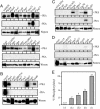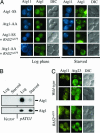An evolutionary proteomics approach identifies substrates of the cAMP-dependent protein kinase
- PMID: 16172400
- PMCID: PMC1236527
- DOI: 10.1073/pnas.0501046102
An evolutionary proteomics approach identifies substrates of the cAMP-dependent protein kinase
Abstract
Protein kinases are important mediators of much of the signal transduction that occurs in eukaryotic cells. Unfortunately, the identification of protein kinase substrates has proven to be a difficult task, and we generally know few, if any, of the physiologically relevant targets of any particular kinase. Here, we describe a sequence-based approach that simplified this substrate identification process for the cAMP-dependent protein kinase (PKA) in Saccharomyces cerevisiae. In this method, the evolutionary conservation of all PKA consensus sites in the S. cerevisiae proteome was systematically assessed within a group of related yeasts. The basic premise was that a higher degree of conservation would identify those sites that are functional in vivo. This method identified 44 candidate PKA substrates, 5 of which had been described. A phosphorylation analysis showed that all of the identified candidates were phosphorylated by PKA and that the likelihood of phosphorylation was strongly correlated with the degree of target site conservation. Finally, as proof of principle, the activity of one particular target, Atg1, a key regulator of autophagy, was shown to be controlled by PKA phosphorylation in vivo. These data therefore suggest that this evolutionary proteomics approach identified a number of PKA substrates that had not been uncovered by other methods. Moreover, these data show how this approach could be generally used to identify the physiologically relevant occurrences of any protein motif identified in a eukaryotic proteome.
Figures




References
-
- Cohen, P. (2002) Nat. Rev. Drug Discov. 1, 309–315. - PubMed
-
- Hunter, T. (2000) Cell 100, 113–127. - PubMed
-
- Hunter, T. (1987) Cell 50, 823–829. - PubMed
-
- Manning, G., Whyte, D. B., Martinez, R., Hunter, T. & Sudarsanam, S. (2002) Science 298, 1912–1934. - PubMed
-
- Manning, B. D. & Cantley, L. C. (2002) Sci. STKE 162, 1–4. - PubMed
Publication types
MeSH terms
Substances
Grants and funding
LinkOut - more resources
Full Text Sources
Molecular Biology Databases

